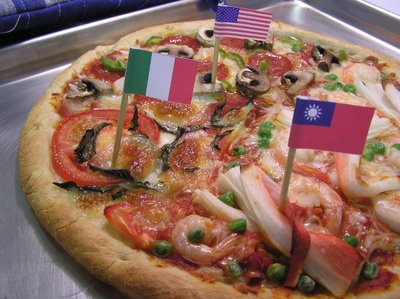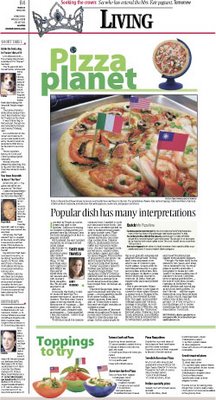
(Kentucky New Era food column for June 28)
I arrived in Taipei as a newlywed and new to the kitchen. Sadly, my training in Chinese cooking never progressed very far because I was too busy sampling local fare to prepare it myself.

My husband Joe and I prided ourselves on trying new and usual things. Like durian—a pale yellow fruit that tastes like custard and smells like dung. Or the less-than-sanitary night markets where we discovered squid stew, oyster omelets and tofu in every form imaginable. We ate and enjoyed it all.
Almost.
Ironically, the foods I couldn’t stomach were the Taiwanese versions of American classics. The first time I saw a pizza crust smothered in an alien array of toppings — like seafood, peas, corn, carrots and diced ham, drizzled with mayonnaise — I was appalled. I was disoriented. I was a long way from home.To fill that small but intense culinary void, I needed to cook my own home-style foods. One time, my co-workers invited us over to make personal pizzas in their toaster oven. They provided pre-made crusts, cheese and warm chocolate chip cookies from Subway (which, incidentally, did not suffer any cultural translation). Joe and I splurged on imported sauce, canned olives, artichokes, capers and other un-Asian veggies. Ten minutes of preparation and presto: we were transported back to American junk-food heaven.
I never acquired a taste for Taiwan specialties like "Seafood Jungle Pizza," but seeing the country’s distinct cultural twist on a non-native dish made me wonder how much American-style pizza has strayed from its Italian ancestor.
The first Neapolitan pizza is said to have had only four toppings — real mozzarella (made from water buffalo milk), sliced tomatoes, fresh basil and oil. Today Italy accepts this and two slight variants as authentic pizza.
Fifteen minutes of Internet research taught me Taiwan is not the only country to violate Napoli’s rules for pizza toppings. In fact, pizza might be the most globally adopted and adapted dish around. In England, tuna and sweet corn adorn one of Domino’s specialty pizzas. Greece adds its national personality to a pepperoni pizza with olives, feta and oregano. In Mexico, pizza with frijoles and chorizo is common. In India, they get topped with lamb and pickled ginger.
But it gets weirder. Many countries seem to use pizza as a base for other ethnic flavors. A recent visit to Taiwan’s Pizza Hut site revealed Korean Kim Chi (aged, spicy pickled cabbage) pizza and German sausage-crust pizza. According to Domino’s Web site, the Netherlands like "Shwarma" flavored pizza. Shwarma is not Dutch invention, but rather Middle Eastern marinated lamb. In Switzerland, people have embraced Tex-Mex pizza spiked with jalepeno peppers.
Though I’ve been back in the states for two years, and what I once believed to be "normal" pizza is readily available, I still prefer to make my own. Lately I’ve been making use of summer’s bounty. I see plenteous topping possibilities—for sale at local farm stands, ripening in backyard vegetable patches and sprouting in my patio herb garden. So don’t be shy ... add the ingredients from your favorite meal to a pizza, or pick toppings that reflect your ethnic background. Or if you’re up for a real challenge, try to create something that’s never been done before. Good luck.
No comments:
Post a Comment